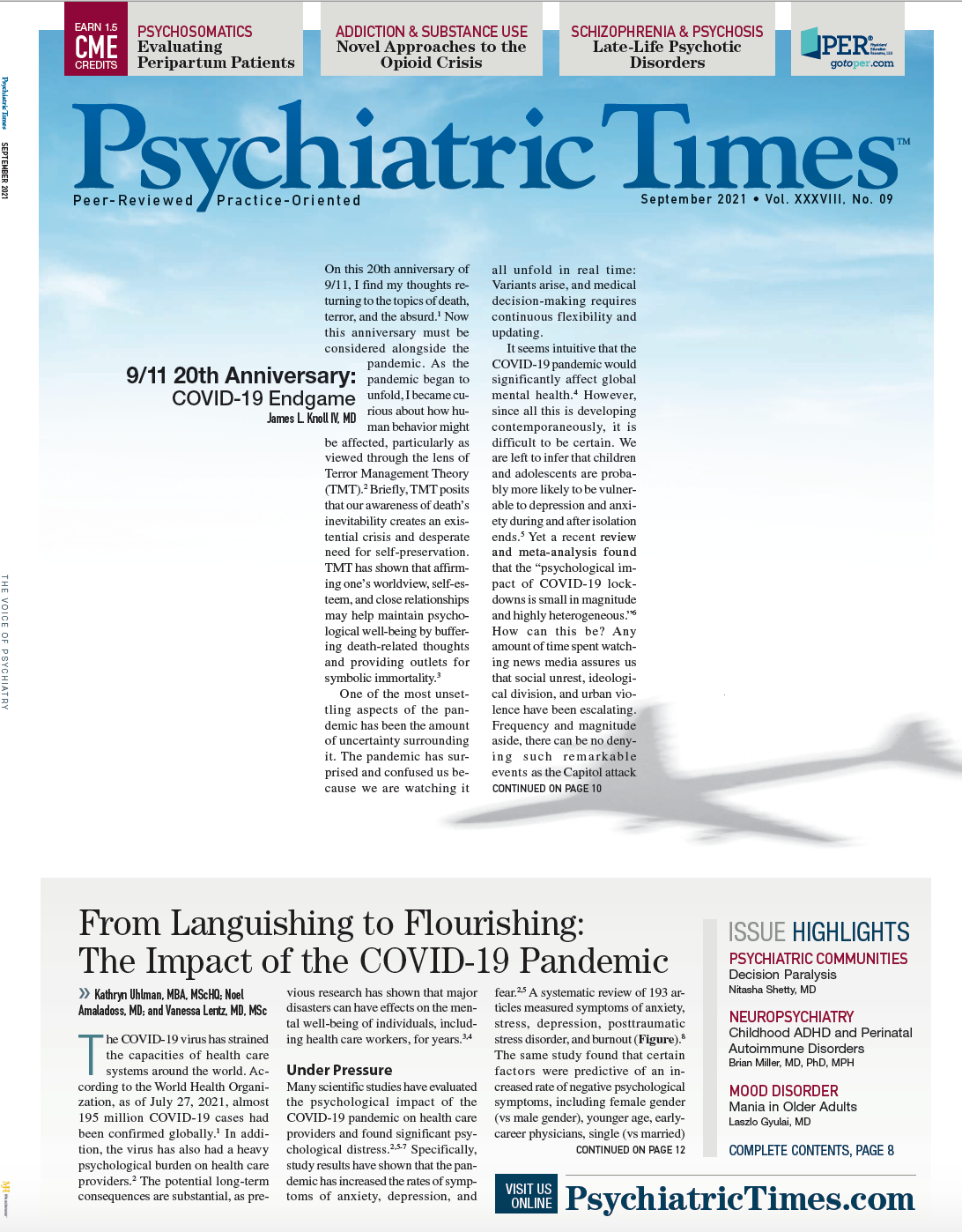From Part 1 of This Special Report
Frank A. Clark, MD
Asian American Mental Health: Treating a Diverse Population at a Crossroads
Geoffrey Z. Liu, MD; Margaret Cheng Tuttle, MD
María José Lisotto, MD; Andrés Martin, MD, MPH
Each Native American tribe has a specific history, traditions, customs, and culture, and knowing something of these will help build the physician-patient relationship.
Daniel Avram/AdobeStock
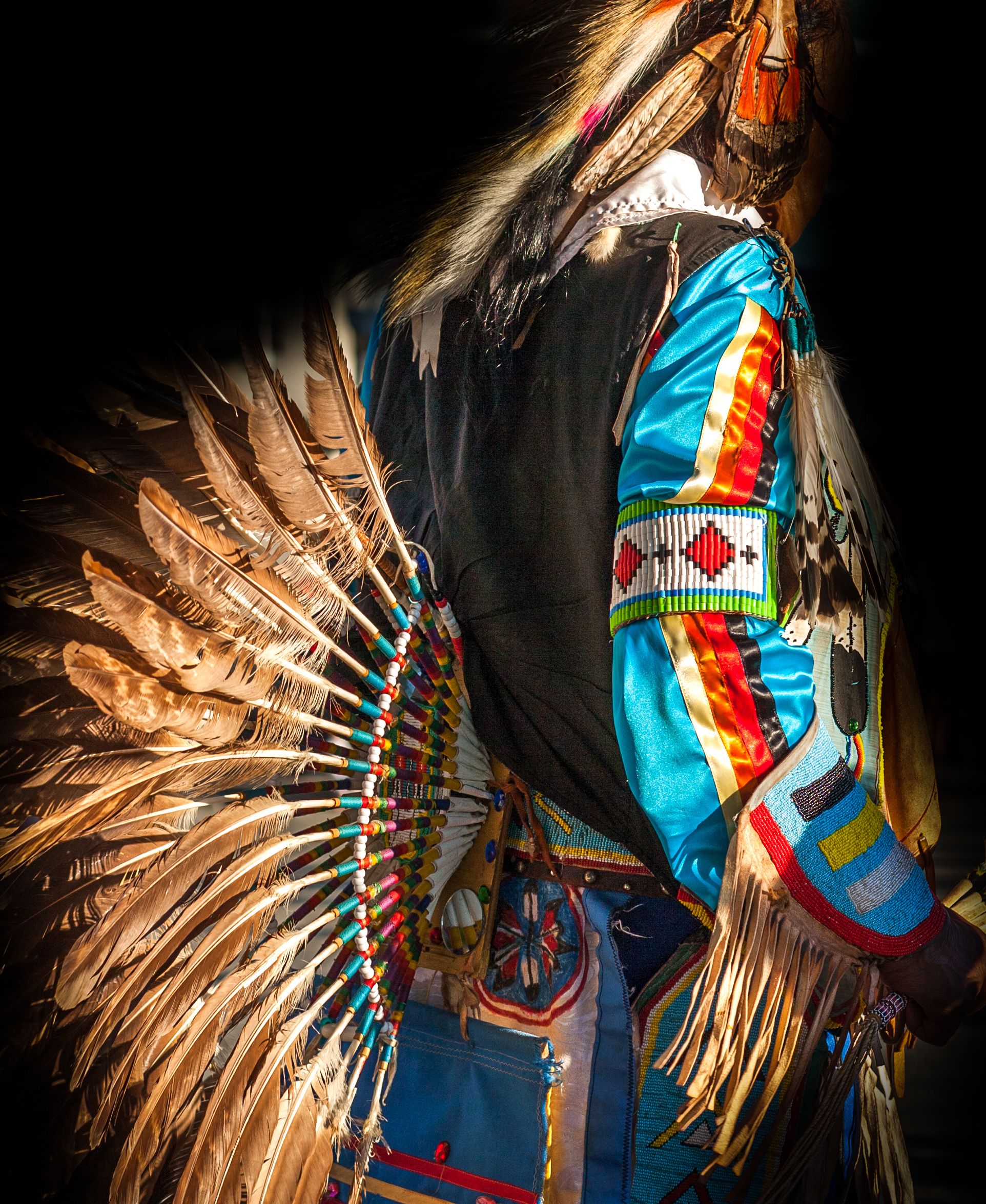
SPECIAL REPORT: MINORITY MENTAL HEALTH PART 2
It is easy to be overwhelmed with the remarkably complex circumstances when considering American Indian and Alaska Native (AI/AN) communities across the United States and the mental health issues and needs of these tribes and/or individuals. Each tribe has a specific history, traditions, customs, and culture, and knowing something of these will help build an understanding of how mental health problems develop and how they are expressed. In addition to learning about a patient’s tribe, gathering a personal history takes time and effort. Issues of poverty, violence, survival, family morbidity and mortality, alcoholism and drug problems, suicide, racism, and historical trauma are often a part of their story.
It might be tempting to start a problem list and then formulate a treatment plan, as has been done so many times before in Western medicine, but what are the issues in need of treatment? What are the odds of a treatment plan resolving the problems? What is the patient’s home environment? It is important to take time to think about the AI/AN communities and why chronic illnesses beset their lives. A historical review sheds light on the causes of behavioral health issues and other chronic medical problems.
Demographics
Frank A. Clark, MD
Asian American Mental Health: Treating a Diverse Population at a Crossroads
Geoffrey Z. Liu, MD; Margaret Cheng Tuttle, MD
María José Lisotto, MD; Andrés Martin, MD, MPH
The AI/AN population is a heterogeneous group of 574 federally recognized tribes with 324 reservations in the United States. Further, there are 63 state-recognized tribes in 11 states,1 and more than 200 tribal groups without any government recognition.2 As of 2019, the collective AI/AN population was estimated to be 6.9 million individuals, about 2% of the total US population. The AI/AN population is spread across different regions, with 78% living outside identified tribal areas, 22% on reservations or other trust lands, and 60% in metropolitan areas. The Native population is significantly younger than that of non-Hispanic Whites.3 The Figure shows a county breakdown of where AI/AN lived according to the US 2010 Census.
Figure. Location of AI/AN Communities
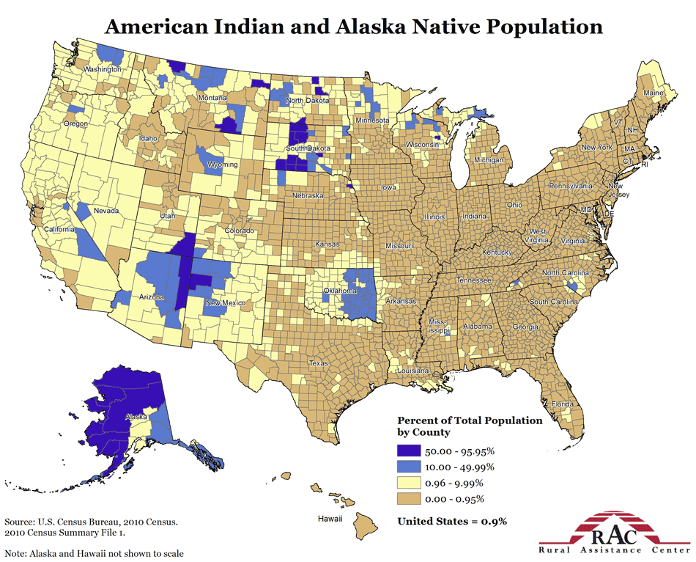
Health Care and Social Services
Federally recognized AI/AN tribes are provided health and educational assistance through several government agencies, with the Indian Health Service (IHS), the Bureau of Indian Affairs (BIA), and the Substance Abuse and Mental Health Services Administration (SAMHSA) having primary responsibilities. State-recognized and nonrecognized Native groups receive assistance through state-, county-, and city-funded health and social programs.
The IHS, established in 1955, operates a comprehensive health service delivery system for approximately 2.6 million AI/AN individuals. Long underfunded, the IHS provides support for about 46% of the health care needs of Native peoples.4 The BIA focuses on education, housing, family and personal safety, and workforce development, and it promotes Native self-determination.5 Along with providing mental health services to all United States citizens, SAMHSA has many dedicated mental health programs, substance abuse treatment programs, and behavioral health prevention programs specifically for Native communities.6
Although vast improvements have been made over the past 20 years, including as part of federal agency efforts, AI/AN people still have a high prevalence of behavioral health problems and limited access to care relative to the overall US population.
Morbidity and Mortality
The State of Mental Health of Black Women: Clinical Considerations
Erica Richards, MD, PhD
The Human Development Index (HDI) uses collective data on life expectancy, education, and income to measure improvement in individuals’ lives. In a critical paper7 comparing well-being among major US ethnic groups, the HDI reported large gaps. The AI/AN group is lowest in wage earnings and second lowest in both education and life expectancy. Taken together, these findings give AI/AN the lowest Health Index in the United States. The AI/AN population is the only group that had negative improvement over the past 10 years. According to 2018 US Census data, the highest poverty rate by ethnicity is found among AI/AN at 25.4%; the White non-Hispanic rate, by comparison, is 10.1%.7
Alarming Statistics
According to data from the Indian Health Service and the Office of the Surgeon General, AI/AN individuals experience serious mental health disparities when compared with the overall US population. Higher rates of addictions, depression, anxiety, and suicide exist. Historical trauma, racism, poverty, inadequate education, unemployment, discrimination in the delivery of health services, and cultural differences coexist with the morbidity and mortality findings for this population.4 These observations suggest that social and economic issues connect with mental health problems and affect treatment outcomes (Table 1).8
Table 1. Mortality and Disparity Rates, Age Adjusted per
100,000 Population, 2009-20114
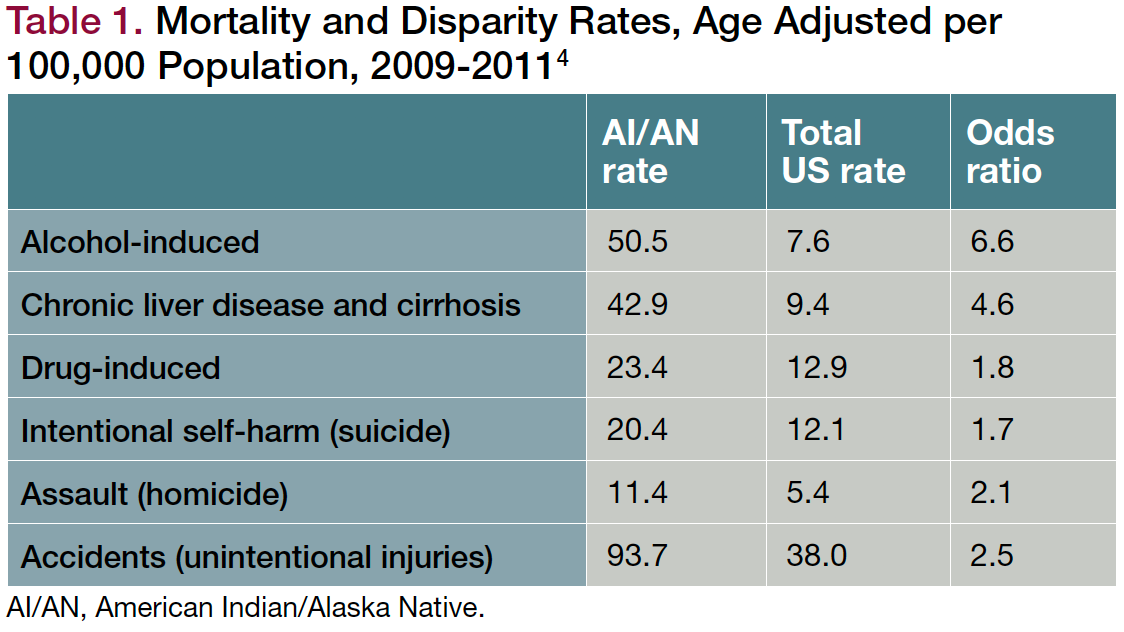
Doctrine of Discovery
What has caused these disparities? Considering the events since the first contact of AI/AN with European explorers and colonizers gives a start in understanding the interrelationship between chronic health issues and social determinants. First, we can look at a series of papal bulls directed to leaders of European monarchies, which encouraged taking possession of lands and Native people in the Americas. The first bull by Pope Nicholas V was issued in 1452 to the Portuguese monarchy, asking Portugal to declare war on all non-Christians worldwide and endorsing conquest, ownership, colonization, and slavery of all non-Christian nations and territories. Forty years later in 1493, shortly following the first voyage of Columbus to the Americas, Pope Alexander VI issued the bull “Inter Caetera” or “The Doctrine of Discovery” to the Spanish monarchy, which gave Spain and Portugal the “right” to vanquish, colonize, convert, and enslave all non-Christian peoples and lands. Ultimately, all European monarchies used these papal bulls as justifications to control lands in the New World.9
As the colonies became independent, they modified their governments to incorporate the message of 1493’s papal bull. When the United States declared its independence in 1776, it retained the British right of discovery and also assumed Britain’s power of dominion. In 1823, the US Supreme Court unanimously adopted the theme of the Doctrine of Discovery into federal law, observing that Christian European nations had assumed “ultimate dominion” over the lands of America during the “Age of Discovery.”10 American Indians, therefore, lost their right to complete sovereignty and retained a right to occupy only certain lands. This Supreme Court decision allowed the Federal government to ignore the rights of American Indians and to claim that the non-Christian lands of America rightfully belonged to, first, the “discovering” Christian European nations, then, subsequently, to the US federal government. Indian nations were deemed “domestic dependent nations” that were subject to the federal government’s absolute legislative authority. Between 1778 and 1871, the United States signed 368 treaties related to land cession with various tribes.10
The Doctrine of Discovery and later Manifest Destiny became the underlying themes for a multitude of negative events affecting indigenous peoples across North America. Tribes were decimated by warfare, disease, ethnic cleansing, and genocide. AI/AN peoples also experienced forced relocation and boarding schools, restrictions of cultural activities, prohibitions on use of their own language, and historical trauma.11 While the Doctrine of Discovery has been rescinded in many churches in the last 2 decades, it is still in place with the Catholic church, and its repercussions echo today.
Social Determinants of Health
Table 2. Tips for Psychiatrists Working With AI/AN Patients
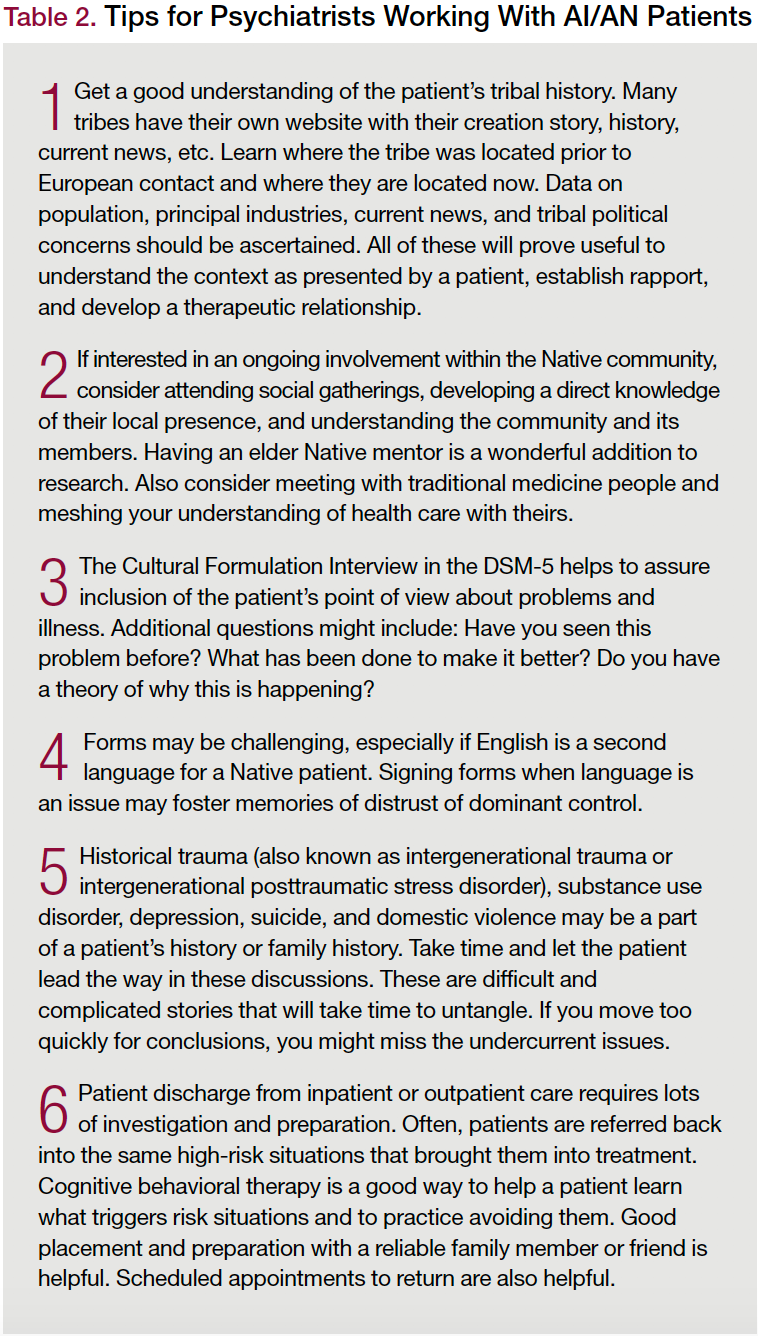
In a series of studies beginning in the late 1960s and continuing to the present, Sir Michael Marmot, PhD, has pursued the impact of social, economic, and political determinants upon various populations. His work in the World Health Organization concerning Indigenous peoples suggests that health care systems need to 1) promote improved education, 2) promote expanded vocational support and improved working conditions, 3) promote healthy living conditions and adequate housing, 4) give every child the best start in life, 5) advocate to establish an income necessary for a healthy life, and 6) pursue the causes of ill health.12 The chronic health illnesses in AI/AN peoples are directly influenced by social, economic, and racial conditions over 5 centuries. Even today, the social and economic conditions in which many AI/AN people live create a negative impact on their morbidity and mortality.13
Conclusions
AI/AN peoples are different from each other and different from the rest of the US population. A long history of social, cultural, and economic struggles has contributed to their increased morbidity and mortality. It is time to address the long-term problems in conjunction with chronic mental health illnesses (Table 2). An integrated partnership with patients and the Native community, focusing on health equity, will go a long way in improving the social determinants of health for this special population. Psychiatrist participation in the process will help us grow in our understanding of the problems, enrich the therapeutic process, and improve treatment outcomes.
Dr Walker is professor of psychiatry emeritus and director of the One Sky Center for American Indian and Alaska Native Behavioral Health at Oregon Health and Science University. His current work draws attention to best practices for the prevention and treatment of addiction and mental health disorders in American Indian populations.
References
1. Salazar M. State recognition of American Indian tribes. LegisBrief: National Conference of State Legislatures. 2016;24(39). https://www.ncsl.org/legislators-staff/legislators/quad-caucus/state-recognition-of-american-indian-tribes.aspx
2. Johnson T. US federally non-recognized Indian tribes—index by state. Updated April 5, 1997. Accessed June 16, 2021. http://www.kstrom.net/isk/maps/tribesnonrec.html#:~:text=Active%20states%20%28reservation%20maps%29%20are%20clickable%20here.%20About,whom%20are%20petitioning%20for%20federal%20recognition.%20Page%20buttons
3. Facts for features: American Indian and Alaska Native Heritage Month: November 2020. News
release. United States Census Bureau. September 30, 2020. Accessed June 16, 2021. https://www.census.gov/newsroom/facts-for-features/2020/aian-month.html
4. Indian health disparities. Indian Health Service. October 2019. Accessed June 16, 2021. https://www.ihs.gov/sites/newsroom/themes/responsive2017/display_objects/documents/factsheets/Disparities.pdf
5. Office of Indian Services. US Department of the Interior Indian Affairs. Accessed June 16, 2021. https://www.bia.gov/bia/ois
6. Home page. Substance Abuse and Mental Health Services Administration. Accessed June 16, 2021. https://www.samhsa.gov
7. Measuring America: ten years and counting. Measure of America. Accessed June 16, 2021. http://www.measureofamerica.org/10yearsandcounting/
8. Department of Health and Human Services. Mental Health: A Report of the Surgeon General. National Institutes of Health; 1999. Accessed June 16, 2021. https://www.loc.gov/item/2002495357/
9. History resources: The Doctrine of Discovery, 1493: a spotlight on a primary source by Pope Alexander VI. Gilder Lehrman Institute of American History. Accessed June 16, 2021. https://www.gilderlehrman.org/history-resources/spotlight-primary-source/doctrine-discovery-1493
10. Newcomb S. Five hundred years of injustice: the legacy of fifteenth century religious prejudice. Shaman’s Drum. 1992 (Fall):18-20.
11. Warne D, Lajimodiere D. American Indian health disparities: psychosocial influences. Soc Personal Psychol Compass. 2015;9(10):567-579.
12. Marmot M. Health in an unequal world. Lancet. 2006;368(9552):2081-2094.
13. Marmot M. Boyer Lectures: Sir Michael Marmot highlights health inequalities and ‘causes of the causes.’ ABC Radio National. September 2, 2016. Accessed June 16, 2021. https://www.abc.net.au/news/2016-09-03/boyer-lecture-sir-michael-marmot-highlights-health-inequalities/7810382 ❒
